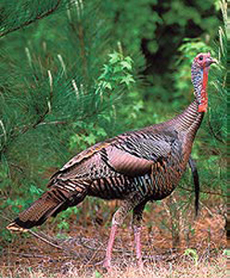TIP OF THE DAY: Thanksgiving Turkey Varieties

|
The turkey is a native American bird. As everyone who went to grade school here knows, it was enjoyed by the Pilgrims and their Wampanoag Native American neighbors at a dinner at the Plimouth Plantation, Massachusetts in 1621.
(Plimouth is how the Pilgrims spelled it. In the 17th century, there was no standardization of spelling. The modern town is spellled Plymouth, but the historical site retains its original spelling.) A celebration of the settlers’ first harvest, this harvest feast was later called “The First Thanksgiving” by 18th-century scholars. The name stuck. Check out more about it below. Fast forward almost 400 years, and we’re consuming 400 million turkeys a year. Ninety-nine percent of them are Broad Breasted Whites, a breed with short legs and a huge breast, bred to meet Americans’ overwhelming taste for white meat. As much as we gobble up those big birds, there’s been rumbling that they’re dry, tasteless, and bear no relation whatsoever to that enjoyed by our forefathers (or even our grandparents). Is that true? We share our notes from a tasting test in the next section. But the choices become confusing, and we’ve addressed them: heirloom versus heritage, wild versus heirloom, and supermarket turkey versus the world. More than 10 breeds are classified as heritage turkeys: Auburn, Buff, Black, Bourbon Red, Narragansett, Royal Palm, Slate, Standard Bronze and Midget White. These were bred long ago from the original wild turkey. Much of the ancient breeding stock survived on family farms, kept as show birds, consumed by the farm families and available in tiny quantities in the locale. But it’s not all deliciousness in Heritage Turkeyland. According to LivestockConservancy.org, the Jersey Buff and Midget White are on the critical extinction list; the Narragansett is on the Threatened list; and the Bourbon Red, Royal Palm, Slate and Standard Bronze are on the Watch list. However… |
|
|
Over the past two decades, as heritage breeds have been “reclaimed” by chefs, expansion of certain heritage breeds has ensured that there’s enough heritage turkey for everyone who wants one. Does that mean you should reach for the Butterball and forget heritage breeds? Not at all! Thanks to Whole Foods for helping to explain these choices. All of Whole Foods Markets’ turkeys come from farms that have been certified by the third-party verified 5-Step Animal Welfare Rating System. They are raised with no antibiotics, no added hormones and no animal bi-products in their feed. Our mother was a Butterball loyalist, and made terrific turkey with moist breast meat, using her various techniques that included brining and covering the breast with foil. If you want an ultra moist turkey, but don’t want to do the brining at home, buy a hand-brined bird that’s ready to roast. (NOTE: Remember not to stuff a brined bird because the stuffing will be too salty.) A few years ago, we were invited to a tasting of different roast turkeys at a prominent culinary school. Except for the Butterball, which was frozen, the birds were fresh. We liked Butterball the best! Here are our tasting notes, with the counsel that it isn’t truly scientific since we didn’t repeat the test. And, birds from different farms could easily yield different results. Tip: If you’re feeding a large group or want white meat leftovers, pick up an extra organic turkey breast to make sure you have plenty of white meat to go around. |
||
|
THE REAL THANKSGIVING FACTS It is a little-known fact that the three-day feast celebrated by the Pilgrims and Wampanoag natives, which we purportedly replicate on the fourth Thursday of each November, was never again repeated in Plimouth Plantation; nor was it deemed by the colonists to be a “Thanksgiving feast.” In fact, days of thanksgiving observed by the Pilgrims were devoted to prayer, not feasting. So we are not replicating the Pilgrims’ Thanksgiving Day each year. That term was bestowed by academics researching the topic in the 18th century. We know that in 1621, the governor of Plimoth Plantation sent four men fowling, and “they four in one day shot as much fowl.” Perhaps it was turkey, perhaps duck, which was also plentiful in the area. The one written record dies not specify. We also know that the native Wampanoag guests killed five deer. About ninety of them attended, and the feast lasted for three days. There’s much to know about the Pilgrims and the Wampanoag People that we never learned in school. But Scholastic.com has the best site we’ve seen on the history of Thanksgiving. We love it! If people are waiting around for dinner, send them here. President Abraham Lincoln declared the first national Thanksgiving Day in 1863, and created the holiday observed since on the fourth Thursday of November. |

|
|
|
|
||




